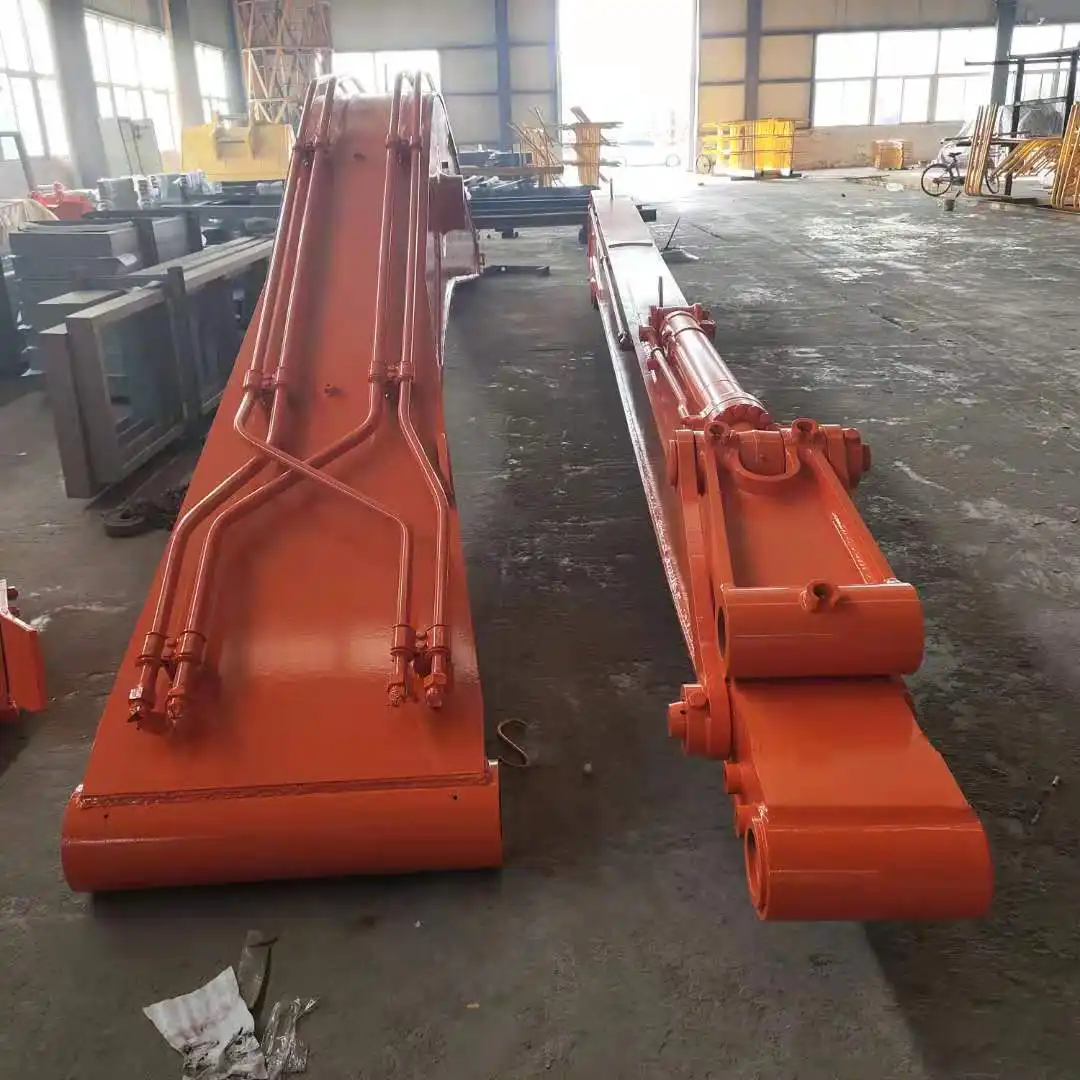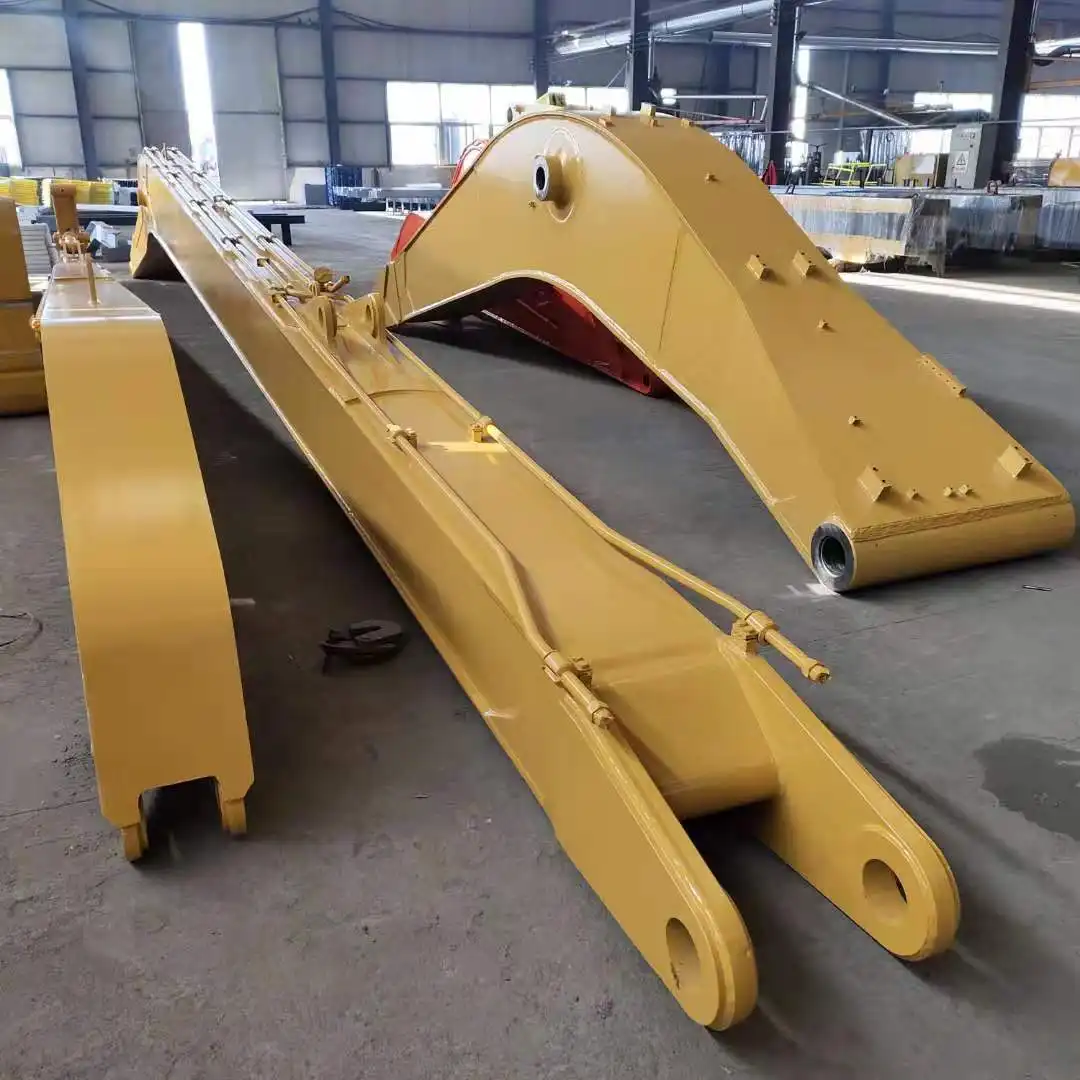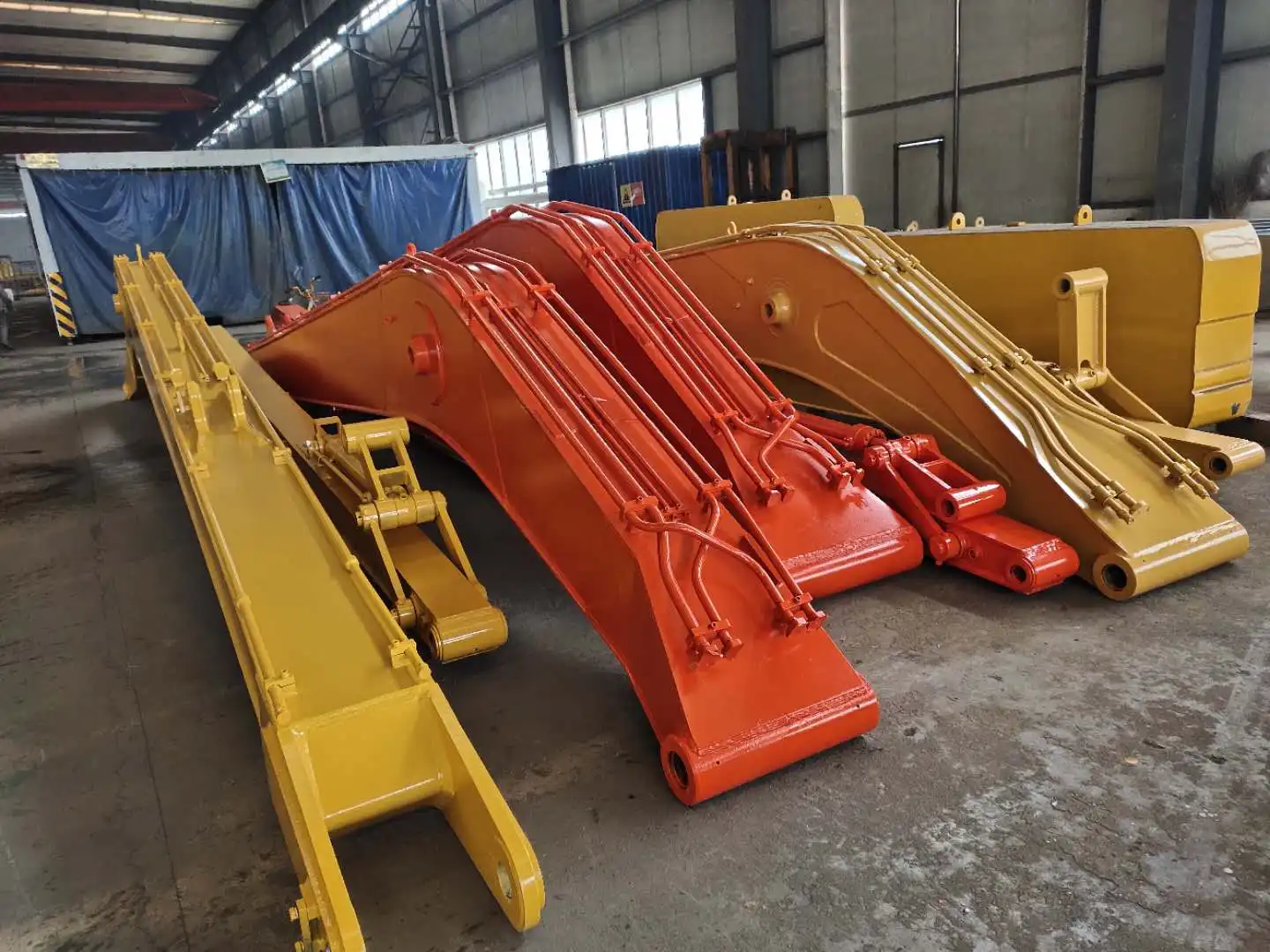What is the name of excavator boom parts?
The excavator boom, a crucial component of any excavator, comprises several essential parts that work together to enable efficient digging, lifting, and material handling. These parts include the main boom structure, stick (or dipper arm), bucket, hydraulic cylinders, pins, and bushings. Each element plays a vital role in the excavator's functionality, allowing operators to perform various tasks with precision and power across industries like construction, mining, and demolition.
Essential Components of the Boom Assembly
Boom Structure: Arm, Stick, and Bucket Connection
The excavator boom structure forms the backbone of an excavator's arm system. It's a robust, typically hollow metal beam that connects the excavator's main body to the stick and bucket. The primary function of the boom is to provide the necessary reach and lifting capacity for various operations.
The arm, also known as the stick or dipper, is attached to the end of the boom. It's responsible for controlling the bucket's reach and dig depth. The stick's length can vary depending on the excavator's size and intended use, with longer sticks offering greater reach but potentially sacrificing some lifting capacity.
At the end of the stick, you'll find the bucket attachment point. Buckets come in various sizes and shapes, each designed for specific tasks such as digging, grading, or handling materials. The connection between the stick and bucket is crucial for transferring power and maintaining stability during operation.
Hydraulic System: Powering Excavator Boom Movement
The hydraulic system is the powerhouse behind an excavator's boom movement. It consists of hydraulic cylinders, pumps, valves, and hoses that work together to provide the force needed for lifting, extending, and retracting the boom assembly.
Hydraulic cylinders are positioned at key points along the boom and stick. These cylinders use pressurized hydraulic fluid to generate the necessary force for movement. The main boom cylinder controls the up and down motion of the entire boom assembly, while the stick cylinder manages the extension and retraction of the stick.
The hydraulic system's efficiency is crucial for the excavator's overall performance. Well-maintained hydraulics ensure smooth, precise movements and optimal power transfer, which is essential for tasks requiring both strength and finesse.
Boom Pivot: Enabling Smooth Rotation and Flexibility
The boom pivot is a critical junction that connects the boom to the excavator's main body. This pivot point allows the boom to rotate horizontally, giving the machine its characteristic swinging motion. The boom pivot consists of heavy-duty bearings and seals that can withstand the immense forces exerted during operation.
The flexibility provided by the boom pivot is essential for efficient excavation and material handling. It allows operators to position the boom accurately without moving the entire machine, saving time and increasing productivity on job sites with limited space.
Regular maintenance of the boom pivot is crucial to ensure smooth rotation and prevent wear that could lead to decreased performance or costly repairs. Proper lubrication and periodic inspections can significantly extend the life of this vital component.

Function of Boom Cylinders and Pins
Boom Cylinders: Controlling Up and Down Movement
Boom cylinders are the muscular hydraulic components responsible for the vertical movement of the excavator's boom. These powerful cylinders are typically mounted between the excavator's main frame and the boom structure. When activated, they extend or retract, causing the boom to rise or lower.
The size and capacity of boom cylinders vary depending on the excavator's size and intended use. Larger machines designed for heavy-duty applications will have more substantial cylinders capable of generating greater force. The precise control of these cylinders is crucial for tasks that require careful positioning, such as placing pipes or lifting heavy objects.
Boom cylinders work in tandem with the hydraulic system to provide smooth, controlled movements. The operator can adjust the speed and power of the boom's motion by regulating the hydraulic fluid flow to these cylinders. This level of control is essential for efficient and safe operation across various job sites and tasks.
Pin Joints: Ensuring Stability and Range of Motion
Pin joints are critical connection points throughout the excavator's boom assembly. These joints allow for pivoting motion between different components while maintaining structural integrity. You'll find pin joints at the connections between the boom and the excavator body, the boom and stick, and the stick and bucket.
The pins used in these joints are typically made of high-strength steel to withstand the enormous forces they encounter during operation. They're designed to distribute stress evenly across the joint, preventing premature wear and ensuring a long service life.
Proper maintenance of pin joints is crucial for optimal excavator performance. Regular greasing helps reduce friction and wear, while periodic inspections can catch potential issues before they lead to costly downtime. Some modern excavators feature automatic lubrication systems to simplify this maintenance task.
Knuckle Boom: Enhancing Excavator Versatility
A knuckle boom, also known as an articulating boom, is a specialized type of excavator boom that offers enhanced flexibility and reach. This design incorporates an additional joint in the boom structure, allowing for a greater range of motion compared to traditional straight booms.
The knuckle boom's extra articulation point enables operators to maneuver the bucket or attachment around obstacles more easily. This feature is particularly valuable in tight spaces or when working on complex projects that require precise positioning.
While knuckle booms offer increased versatility, they also introduce additional complexity to the excavator's design. The extra joint means more moving parts and potential maintenance points. However, for many operators, the added flexibility and improved reach make knuckle booms a worthwhile investment for certain applications.

Identifying Wear-Prone Boom Parts
Bushings and Bearings: High-Friction Areas to Monitor
Bushings and bearings play a crucial role in the smooth operation of an excavator's boom assembly. These components are found at various pivot points and joints, where they reduce friction between moving parts and help distribute loads evenly. Due to their constant exposure to high pressure and movement, bushings and bearings are among the most wear-prone parts of the boom assembly.
Regular inspection of these components is essential to catch signs of wear early. Symptoms of worn bushings or bearings can include increased play in the joints, unusual noises during operation, or visible scoring on the surfaces. Timely replacement of worn bushings and bearings can prevent more severe damage to other boom components and maintain the excavator's overall performance and efficiency.
Some modern excavators feature sealed or lubricated-for-life bushings, which can significantly extend service intervals. However, even these advanced components require periodic inspection to ensure they're functioning correctly.
Hydraulic Seals: Preventing Leaks and Maintaining Power
Hydraulic seals are critical components in the excavator's boom cylinders and other hydraulic elements. These seals prevent hydraulic fluid leakage, ensuring the system maintains proper pressure and operates efficiently. Over time, the high pressures and constant movement can cause these seals to wear or degrade.
Leaking hydraulic seals can lead to several issues, including reduced power, decreased precision in boom movements, and potential environmental contamination from leaked hydraulic fluid. Regular visual inspections can help identify early signs of seal failure, such as oil stains or dampness around cylinder ends or hydraulic fittings.
Replacing worn hydraulic seals promptly is crucial for maintaining the excavator's performance and preventing more extensive damage to the hydraulic system. Many operators choose to replace seals preemptively during scheduled maintenance to minimize the risk of unexpected failures during critical operations.
Boom Tip: Stress Point Requiring Regular Inspection
The boom tip, where the stick attaches to the main boom structure, is a critical stress point in the excavator's arm assembly. This area experiences significant forces during operation, particularly when the bucket is fully extended or when performing heavy lifting tasks.
Regular inspection of the boom tip is essential to identify any signs of stress, such as cracks, deformation, or excessive wear on the attachment points. Early detection of issues in this area can prevent catastrophic failures that could result in significant downtime and repair costs.
Maintenance of the boom tip often involves checking and tightening bolts, inspecting welds, and ensuring proper lubrication of moving parts. Some manufacturers recommend periodic non-destructive testing, such as ultrasonic or magnetic particle inspections, to detect hidden flaws in the boom tip's structure.
Understanding the names and functions of excavator boom parts is crucial for efficient operation and maintenance. From the main boom structure to the intricate hydraulic systems, each component plays a vital role in the excavator's performance. Regular inspections, timely maintenance, and proper operation can significantly extend the life of these parts, ensuring your excavator remains a productive asset on any job site. By staying informed about the latest innovations and best practices in excavator maintenance, operators and fleet managers can optimize their equipment's performance and reduce overall operating costs.

FAQ
1. How often should excavator boom parts be inspected?
Excavator boom parts should be inspected daily for visible damage and at least monthly for more thorough checks. However, the frequency may vary based on usage intensity and working conditions.
2. Can I use aftermarket parts for excavator boom repairs?
While aftermarket parts can be a cost-effective option, it's crucial to ensure they meet OEM specifications. Using high-quality aftermarket parts from reputable suppliers can be a viable alternative to OEM components.
3. What causes premature wear in excavator boom components?
Premature wear can result from overloading, improper operation, inadequate lubrication, or exposure to harsh environmental conditions. Regular maintenance and proper operation can significantly extend component life.
4. How can I improve the efficiency of my excavator's hydraulic system?
Regular fluid changes, keeping the system clean, maintaining proper fluid levels, and promptly addressing leaks can all contribute to improved hydraulic system efficiency.
5. Are there any innovations in excavator boom design to watch for?
Recent innovations include lightweight materials for improved fuel efficiency, smart hydraulic systems for precise control, and modular designs for easier maintenance and customization.
China Excavator Boom Supplier
TianNuo Machinery stands out as a leading excavator boom manufacturer in China. Their product line encompasses a wide range of excavator components, including standard arms, extended arms, and specialized attachments for various applications. TianNuo's expertise extends to railway maintenance equipment, excavator modification solutions, and engineering arms designed for specific tasks. Their commitment to quality and innovation is evident in their diverse product offerings, which cater to the needs of construction, mining, and demolition industries. For those seeking reliable excavator solutions, you can contact us at boom@stnd-machinery.com.
References
- Smith, J. (2022). "Advanced Hydraulic Systems in Modern Excavators," Journal of Construction Engineering, 45(3), 78-92.
- Johnson, R. & Brown, L. (2021). "Wear Patterns and Maintenance Strategies for Excavator Booms," Heavy Equipment Maintenance Quarterly, 18(2), 110-125.
- Zhang, Y. et al. (2023). "Innovations in Excavator Boom Materials and Design," International Journal of Mechanical Engineering, 56(4), 301-315.
- Miller, T. (2020). "Operator's Guide to Excavator Boom Maintenance," Construction Equipment Operations, 3rd Edition, Buildright Publishing.
- Davis, E. (2022). "Environmental Impacts of Hydraulic Fluid Leaks in Construction Equipment," Environmental Science & Technology, 39(1), 45-58.
- Lee, S. & Park, H. (2021). "Stress Analysis of Excavator Boom Structures Under Various Loading Conditions," Journal of Structural Engineering, 147(5), 04021046.
About Author: Arm
Arm is a leading expert in the field of specialized construction and railway maintenance equipment, working at Tiannuo Company.

